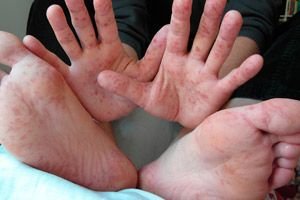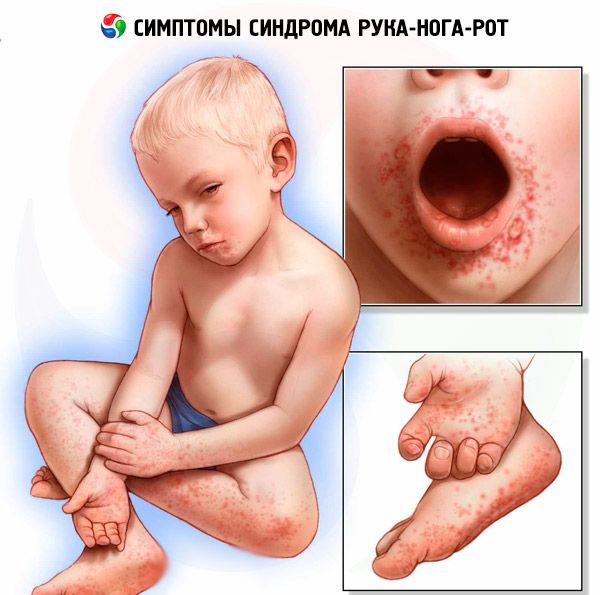
All iLive content is medically reviewed or fact checked to ensure as much factual accuracy as possible.
We have strict sourcing guidelines and only link to reputable media sites, academic research institutions and, whenever possible, medically peer reviewed studies. Note that the numbers in parentheses ([1], [2], etc.) are clickable links to these studies.
If you feel that any of our content is inaccurate, out-of-date, or otherwise questionable, please select it and press Ctrl + Enter.
Hand-foot-mouth syndrome
Medical expert of the article
Last reviewed: 04.07.2025

Hand-foot-and-mouth disease, or enterovirus vesicular stomatitis with exanthema, is a contagious viral infection that most often occurs in young children under 5 years of age. The disease is a complex of symptoms that manifest as enanthem (the appearance of ulcers on the oral mucosa) and exanthema (the appearance of rashes on the legs and arms).
 [ 1 ]
[ 1 ]
Causes of hand-foot-mouth syndrome
The cause of the syndrome are the following types of Coxsackie enteroviruses: A16, A5, A10, A9, B1, B3, 71, as well as oligoviruses and echoviruses. These are RNA-containing viruses, they are quite viable in the external environment - they can survive for 14 days at a temperature of 20-25 degrees.
Outbreaks of the disease most often occur in summer and autumn. Infection occurs through airborne droplets or the feco-oral route. The virus can be transmitted through any household item - for example, through dishes, children's toys, as well as hygiene and bedding. But mainly infection occurs during a simple conversation, as well as when coughing or sneezing. Healthy carriers of the virus are just as contagious as those who are sick.
Typically, a person with hand, foot, and mouth disease is most contagious during the first week of illness, and sometimes for days or weeks after symptoms disappear. Some people, especially adults, have no symptoms but can still transmit the virus to others. That's why people should always try to practice good personal hygiene (such as hand washing) to minimize their chances of becoming infected.
Pathogens
Symptoms of hand-foot-mouth syndrome
The first symptom of hand-foot-and-mouth disease is a temperature that rises to 37.5-38º. Then signs of intoxication syndrome appear - headache and muscle pain, general weakness, and a sore throat begins. The fever itself lasts 3-5 days. In general, the disease initially resembles ARVI very much.
But in addition to other symptoms, on the 1st/2nd day of illness, rashes no more than 3 mm in diameter with a rim of redness around them, resembling vesicles, appear on the palms or back of the hand, as well as the soles or feet (sometimes on the buttocks and back of the thighs). A vesicle is a transparent cystic element that rises slightly above the skin surface. They do not develop like a normal rash, but in the opposite order - the vesicles do not open, but disappear, becoming similar to healthy skin. Such a rash lasts for about 5-7 days, after which it completely disappears.
Along with the skin rash, small ulcers also appear in the mouth - they are quite painful and very sensitive to spicy and hot food. Aphthous stomatitis can also appear on the gums, the inner surface of the cheeks, the soft and hard palate. Because of stomatitis, appetite disappears, the child becomes capricious and irritable. There are also difficulties with eating, strong salivation and a sore throat.
 [ 13 ]
[ 13 ]
First signs
The syndrome has an incubation period that lasts on average 3-6 days. At the same time, the child becomes lethargic, indifferent to what is happening around. Also among the first signs of the disease are rumbling in the stomach and loss of appetite.

People of any age can become infected with this virus, but hand, foot and mouth disease usually affects young children – no older than 3 years old.
 [ 14 ]
[ 14 ]
Complications and consequences
Enterovirus 71 infection in hand-foot-and-mouth disease can have quite severe consequences and complications. These can include encephalitis and aseptic meningitis.
Symptoms of complications include a temperature increase of over 39º, vomiting begins (may be repeated), headaches increase, pain in the eyeballs appears, the child is capricious and cries during the fever, he/she is drowsy, or, on the contrary, psychomotor agitation occurs. If you notice such signs in your child, you should immediately call a doctor.
Diagnostics of hand-foot-mouth syndrome
Usually, the disease is diagnosed based on the clinical picture, when all infectious diseases that cause characteristic rashes (such as rubella, chickenpox or measles) are excluded. The main diagnostic signs of hand, foot and mouth disease include:
- The disease begins with mild intoxication along with fever;
- After 1-2 days, exanthema appears simultaneously on the skin of the legs and arms (feet, palms), as well as enanthem in the mouth;
- There are no signs typical for other infectious diseases (pulmonary syndrome, tonsillitis, disorders in the lymphatic system, etc.).
Tests
- General blood test. Typical changes for a viral infection are characteristic: leukocytosis, decreased neutrophils, increased lymphocytes, ESR is usually within normal limits.
- Virological studies, PCR diagnostics (enteroviruses are isolated in washes, as well as smears taken from the throat).
- Serological tests (specific antibodies are detected in the blood serum).
What tests are needed?
Differential diagnosis
Differential diagnostics are carried out with the following diseases: aphthous stomatitis, herpes, Stevens-Johnson syndrome, herpangina. In the latter disease (another type of enterovirus infection), mouth ulcers also spread to the tonsils, which allows it to be differentiated from hand-foot-and-mouth disease.
Who to contact?
Treatment of hand-foot-mouth syndrome
If the disease proceeds without complications, its symptoms disappear on their own within a week (very rarely they last up to 9-10 days).
Most patients will benefit from outpatient treatment. They are prescribed a special diet - it must be balanced and gentle, both chemically and mechanically. Food must be warm and liquid (or semi-liquid); excessively spicy, salty and hot foods are prohibited. It is also necessary to follow a drinking regimen to reduce fever and remove toxins from the body.
Treatment of hand, foot and mouth disease with medications can be symptomatic or etiotropic.
Local treatment is also carried out - gargling with a warm solution of sage and soda, solutions of substances such as furacilin or chlorhexidine.
Medicines
To reduce pain due to ulcers that have appeared in the mouth, and also if the baby has a fever, weakness, chills, pain in the joints and muscles, an antipyretic drug is excellent - this can be Ibuprofen or Paracetamol. In addition, Panadol, Nurofen, and Efferalgan will help with high temperatures (aspirin should not be taken - it can cause Reye's syndrome).
For skin rashes, antihistamines are prescribed - Zodak, Claritin or Cetrin.
To prevent recurrent bacterial infection, use Panthenol and Tantum Verde sprays. For resorption, take Immudon.
Interferon inducers may also be prescribed: adult or children's anaferon, as well as aflubin, etc.
Correction of metabolism in a child consists of vitamin therapy. Thus, it is necessary to give him vitamins of group B1 and B2, as well as nootropics (piracetam) and calcium glycerophosphate from the first days of the syndrome and after recovery.
There is no physical therapy treatment for hand, foot and mouth syndrome.
Traditional methods of treating hand-foot-and-mouth disease
Take 1 teaspoon of mint and calendula, pour 1 glass of boiled water over them. Strain the tincture after half an hour. Take half a glass three times a day.
Boil 250 g of viburnum berries in 1 liter of water for 10 minutes. Then strain and add 3 spoons of honey to the tincture. Take 100 ml 3 times a day.
Pour 1 cup of boiling water over 1 tbsp of viburnum blossom and cook for 10 minutes. The solution should be taken three times a day, 1 tbsp.
Pour 1 cup of boiling water over willow branches, birch buds and elm bark (2 teaspoons of each) and cook the mixture for 20 minutes. Then cool the solution and strain. Drink 1 tablespoon three times a day.
 [ 27 ], [ 28 ], [ 29 ], [ 30 ]
[ 27 ], [ 28 ], [ 29 ], [ 30 ]
Herbal treatment
This syndrome can also be eliminated with the help of herbal treatment.
1 tbsp of the mixture, consisting of 2 parts of violet grass and linden flowers, as well as 1 part of elder flowers, fennel and rhizome seeds, is poured with a glass of water. Leave the mixture to infuse for 2 hours. Then boil it and let it stand on the stove for another 2 minutes. The tincture should be drunk during the day.
Take elderberry and linden blossom (2 parts), chamomile, peony, licorice root (1 part) and nettle (3 parts), chop them and mix. Then pour 2 tbsp of the resulting mixture into 0.5 l of boiling water. Let the solution stand for 15 minutes, then strain. During the day, the decoction should be drunk in small portions.
Pour a pinch of black cohosh herb into 1 glass of boiling water, then strain the decoction and drink 150 ml, having first diluted it in milk.
Take equal portions of the following herbs: lemon balm, marsh cudweed, oregano, linden blossom, hop cones, coriander seeds, valerian root, and motherwort and grind them. Pour one tablespoon of the mixture into a thermos, pour 0.5 liters of boiling water over it and leave for 1 hour. The resulting decoction should be drunk 3 times a day, 100 g each.
Homeopathic remedies are not used for hand, foot and mouth disease.
Prevention
As a preventive measure against the disease, during an epidemic, it is necessary not to take the child to places where there are usually large crowds of people (for example, to clinics). If you absolutely must go, lubricate his nose with oxolinic ointment. In addition, you should regularly ventilate the room in which the child stays during the day and wash his hands often.
Forecast
Hand, foot and mouth disease has a favorable prognosis - usually after recovery, the child develops lifelong type-specific immunity. But in some cases, re-infection is possible if the causative agent of the infection is a different serotype of enterovirus (for example, secondary infection with the Coxsackie virus type B3 is quite possible after an illness that began due to the virus type A16).

